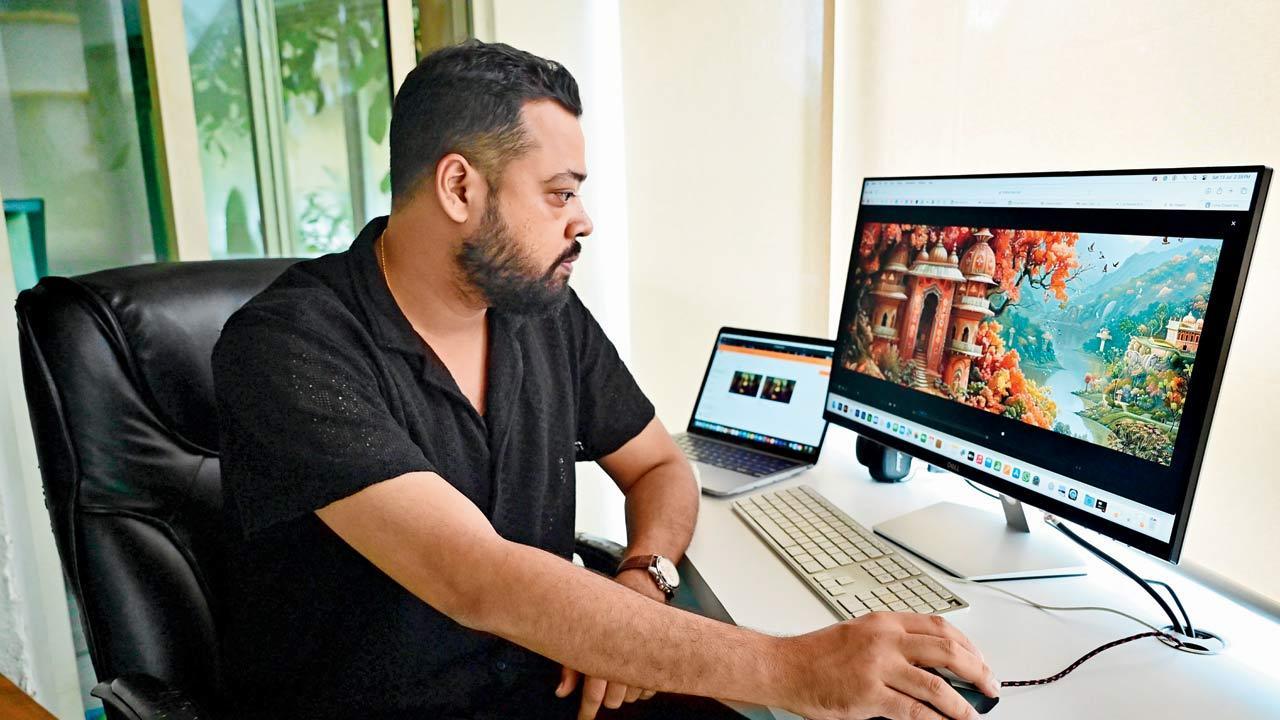This Mumbai-based AI filmmaker is transforming Mumbai’s landscape with an Anime aesthetic

Mumbai’s adaptability and constant forward momentum resonates with Priyanku’s approach to AI art. Pic/Shadab Khan
In the AI content arena, a name is making waves. Priyanku Sarmah, a Santacruz-based AI filmmaker uses the latest artificial intelligence to create captivating films, photos and Reels, and has drawn millions of eyes to his social media account.
ADVERTISEMENT
Sarmah, a history buff, loves to fuse the past with the future in his work. His deep fascination with AI technology has given wings to his imagination of history. “I have always imagined what ancient India looked like… Can you imagine what places like Dwarka must have looked like during Krishna’s time?” he asks. With AI at his disposal, he brings these ancient worlds to life.

One of his most celebrated reels, blending anime aesthetics with Mumbai’s chaos, gained over 12 million views and 2 million likes. As a fan of Studio Ghibli, known for its enchanting portrayal of cities and cultures, Sarmah found the perfect inspiration in Mumbai’s charm. “Mumbai has this anime vibe with its visual diversity, and I have always wondered what anime would look like in India. That’s where the idea came from,” he says. “The world of AI is super exciting, especially if you already have a deep interest in something like history. AI gives you the power to reimagine it” Sarmah says.
Blending cultures
Sarmah has also touched upon historical and cultural themes, such as the Revolt of 1857 and Ganesh Chaturthi, often blending them, too, with anime aesthetics. His first reel on Nalanda University garnered 1.2 million views, sparking a conversation about how ancient Indian universities might have looked in their prime. “Creating these reels often involves starting with a blank space in mind,” he explains. “I describe my impromptu visions to the AI, which then generates images from its vast database. Sometimes the structures are inaccurate, but that is at least a starting point. I continue to make changes as I progress with the piece.”
Sarmah started working on these AI projects in February 2023 and has made dozens of photos and videos since then. He is completely self-taught. But he has always been a tech buff, frequently involved in beta testing various software tools. However, he hesitates to label his work as “traditional art”. For him, AI is a collaborator, a tool that bridges human creativity and machine efficiency. “Art has always been derivative,” he muses, adding, “Every artist finds inspiration somewhere. I find mine in history. Using AI doesn’t change that; it’s like choosing a pen you enjoy writing with,” he says.
“When I started experimenting with AI, I didn’t know what to expect,” he says. “The technology was still in its nascent stages, and I was hesitant to call my work ‘art’ in the traditional sense. But as I delved deeper, I realised that AI is a powerful tool, that can help bring my creative visions to life.”
Prompts are the key
On the role of prompts, he says, “It acts as the backbone of this technology. The better you understand the technology, the more effectively you can communicate your vision,” he says. Crafting the perfect prompt is like sharpening a knife, he says. “The more you practice, the better you become. As technology grows, so does its ability to understand and generate human-like images. It’s a fascinating process,” adds Sarmah.
Living in Mumbai has profoundly influenced Sarmah’s art. The city’s adaptability and constant forward momentum resonates with his approach to AI. “Mumbai is always moving forward, striving for better,” he notes. “This mindset aligns perfectly with how I view AI—which is also constantly evolving.” Platforms like Runway Gen 3, which offer video generation capabilities, have revolutionised his work. What started as image-based reels have now evolved into dynamic videos, democratising storytelling for millions.
Looking ahead, Sarmah is excited about the future of AI in the art world. Now, he sees himself as an AI filmmaker, a distinction highlighted by his success in Runway’s 48-hour challenges, where his film was the only one from India to make it to the top 40. The challenge involves making AI-generated films using the software in 48 hours. His upcoming projects include a film centred around Ganga, exploring the river’s significance through a narrative without a voiceover.
The AI filmmaker sees artificial intelligence as a democratising force that allows millions of storytellers, who previously lacked the capacity, to share their stories. “This technology is shifting the job market,” he notes. “It’s allowing a new format of production,” he also says.
Sarmah says his work is not just about creating art, but also about redefining what’s possible with the latest technology.
What is it? Using artificial intelligence to create films and photos.
How it works? The artist/storyteller can refine outputs through prompts that the AI has created by processing its databases.
Who it affects/benefits? It democratises content creation, enabling millions of storytellers—especially those without traditional artistic training—to produce professional-quality visuals.
 Subscribe today by clicking the link and stay updated with the latest news!" Click here!
Subscribe today by clicking the link and stay updated with the latest news!" Click here!








